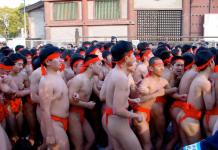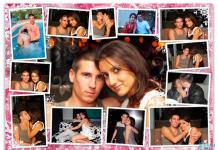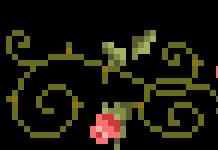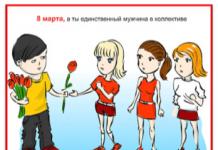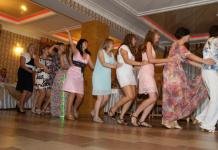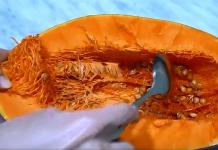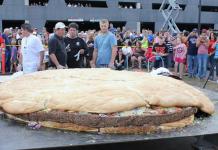Immediately after the baby is born, they check whether he has dysplasia of the hip joints or congenital shortening of the hips or legs. If the neonatologists missed the defects, then the orthopedist or surgeon at the clinical examination in 1 month will correct the situation. But the mother herself should pay attention to important signs: if you put the baby on the back, and then bend its legs so that the baby's feet stand on the changing table, then the knees should be at the same level. Asymmetrical folds under the buttocks and on the hips should also be discussed with your doctor.
Output. Fixing splints, cushions and stirrups, installed up to 6 months, should eliminate hip dysplasia, and the operation will lengthen the shortened parts.
2. Where are the knees looking? Clubfoot in children
Clubfoot in a child can be serious and temporary. In the first case, the child's foot (one or both) and the ankle are turned inward strongly, almost 90 °. And you can notice this feature almost immediately after birth. The second situation is absolutely natural, by the age of 2 it is corrected by itself, but sometimes the process is delayed up to 3-4 years.
Output. The treatment of severe clubfoot in a child begins at 2 weeks of age. Usually massage and physiotherapy exercises are practiced. If after six months there is no result, they think about the operation.
3. O or X?
In some children under 3-4 years old, when walking, the legs are located with the letters O, X, or both knees look in different directions. It is important to ensure that after two years this feature does not worsen, there are no joint pains and discomfort when walking. The child manages to finally adapt to life in an upright state only by adolescence, which means that everything that happens before fits into the concept of the norm.
Output. In any case, consultations with a specialist once every six months, massage and physiotherapy exercises will not interfere.
4. Loose support: flat-valgus or varus foot in a child

Doctors make the diagnosis “flat feet” not earlier than 5 years, and before that they use the terms “flat-valgus foot” - the feet are strongly “overwhelmed” on the inner part, and “varus” - the outer edges serve as a support. The first deformity can develop into flat feet in a child. It becomes difficult for a kid to walk for a long time, and his new shoes in just 1–2 months are worn down from the inside. The second situation never leads to flat feet in a child, but it also gives an increased load on the joints of the legs and the spine, turning around at least in a stoop.
Output. With timely correction with the help of physiotherapy, the defect is most often eliminated in a few years.
5. What will the child's gait tell about?
There are several incorrect gaits in children. One - the child rests on his toes, lifts and turns his heels outward, slightly bends his legs at the knee and hip joints, and brings the hips together. The second is identified by dragging the right or left leg, as well as the arm bent and pressed to the body on the same side. The next time the child's gait is characterized by excessive, inappropriate, pretentious movements of the limbs, for example, the knees are raised high, and the feet are "spanked".
Output. For any deviation from the norm, the baby should be shown to a surgeon, orthopedist and neurologist. Most of the listed features are associated with disruptions in the development of the brain or spinal cord and require timely correction.
Doctor's advice
If you notice that the baby for no apparent reason (uncomfortable shoes) began to limp, drag a leg or take unusual postures when sitting, lying or standing, urgently consult a specialist - a surgeon or orthopedist. The same should be done if the joints are swollen and hot to the touch. Sometimes colds and flu cause inflammation in the musculoskeletal system. And successful recovery depends on how quickly treatment is started. Until the child is tested, it is important to minimize the stress on the affected leg.
6. The child has sweaty feet

Output. Traditional medicine offers many methods for treating sweating of the feet in children - foot baths with infusions of oak bark, sage, string, hardening (walking barefoot, dousing cold water), foot massage, various ointments and powders.
7. Calf pain
Parents need to pay due attention to children's complaints of pain in the lower extremities, ask where exactly and what is happening, track changes in the child's gait. Most of the complaints are due to bruises and sprains during active games. Smaller - becomes a consequence of uneven growth of bone and muscle tissue. The zones of more intensive development are ahead of the lagging ones, causing discomfort in them. One fifth of children experience leg pain in the evening. Blood circulates well during the daytime, but at night the blood flow decreases and pain occurs. A light massage should relieve the unpleasant sensation.
Output. As soon as the child has reported pain in the legs, it is necessary to examine him. Pay attention to general well-being, appetite, body temperature, mood. However, not all cases are so harmless, and it is better to discuss the situation with your doctor.
8. Orthopedic shoes for children
According to statistics, 95% of children are born with healthy legs, but with age, about a third of them acquire various pathologies of the musculoskeletal system. Orthopedic shoes for children can correct many defects in the bones and joints of the legs. It is impossible to buy such things without a doctor's prescription, you can harm the correct development of the child's feet or aggravate existing problems.
Output. The best amenable to correction with the help of orthopedic shoes for children is flat feet in a child, as well as hallux valgus and varus deformities of the feet.
9. Already in heels?
Actress Katie Holmes and model Heidi Klum caused a public outcry when they let their 4-year-old daughters wear high-heeled shoes. Such antics have been called "parental failure." According to experts, the consequences of such a violation are stretching of the ligaments and curvature of the shape of the foot in a child, as well as deformation of the spine, which will inevitably lead to malfunctions in the work of internal organs.
Output. Shoes of fashionistas under 7 years old should have a heel no higher than 5–7 mm.
10. Let's put on our shoes! The right shoes for toddlers

The first shoes are put on as soon as the baby begins to learn to walk. The first shoes for children must have tall tough heel counter, arch support to form the arch and a spacious toe that does not squeeze the forefoot.
Output. It is imperative to buy the first shoes for a child with shoes. We suggest the following procedure. Let the baby put on an update and look a little like in it, and you watch if his gait has changed.
Charging game for legs
A good prevention of planovalgus deformity and flat feet can be simple gymnastics, which can be easily turned into fun game... Exercises should be performed daily, 5-7 times each.
Uncover your baby and offer him:
* alternately and synchronously bend and straighten the toes on each leg;
* rotate the feet clockwise and counterclockwise;
* walk on toes, heels and leaning on the outer part of the foot;
* collect small objects from the floor with your toes: pebbles, balls, details from a designer with a diameter of 3-4 cm (a complicated version of this exercise looks like this: scatter small objects on the floor, cover them with a handkerchief and invite the crumbs to collect everything without removing the cover);
* sitting on a chair, alternately rolling a tennis ball or a gymnastic stick with your right and left foot;
* walk slowly, holding a tennis ball between your feet;
* to resist, holding the hands of an adult, on a fitball, trying to maintain balance;
* walk on a narrow log and climb the rungs of a rope ladder.
- Atactic gait:
- cerebellar;
- stamping ("tabetic");
- with a vestibular symptom complex.
- "Hemiparetic" ("mowing" or by the type of "triple shortening").
- Paraspastic.
- Spastic-atactic.
- Hypokinetic.
- Apraxia of walking.
- Idiopathic senile dysbasia.
- Idiopathic progressive "freezing dysbasia".
- Gait in "skating position" with idiopathic orthostatic hypotension.
- "Peroneal" gait - one-sided or two-sided stepping.
- Walking with hyperextension of the knee joint.
- "Duck" gait.
- Walking with pronounced lordosis in the lumbar region.
- Gait in diseases of the musculoskeletal system (ankylosis, arthrosis, tendon retractions, etc.).
- Hyperkinetic gait.
- Dysbasia with mental retardation.
- Gait (and other psychomotor) with severe dementia.
- Psychogenic gait disorders of various types.
- Dysbasia of mixed origin: complex dysbasia in the form of gait disturbances against the background of certain combinations of neurological syndromes: ataxia, pyramidal syndrome, apraxia, dementia, etc.
- Dysbasia iatrogenic (unstable or "drunk" gait) with drug intoxication.
- Dysbasia caused by pain (antalgic).
- Paroxysmal gait disturbances in epilepsy and paroxysmal dyskinesias.
Atactic gait
The movements in cerebellar ataxia are poorly commensurate with the features of the surface on which the patient is walking. The balance is disturbed to a greater or lesser extent, which leads to corrective movements, giving the gait a chaotic-chaotic character. It is characteristic, especially for the defeat of the cerebellar worm, walking on a wide base as a result of instability and staggering.
The patient often staggers not only when walking, but also in a standing or sitting position. Sometimes titubation is detected - a characteristic cerebellar tremor of the upper half of the body and head. Dysmetria, adiadochokinesis, intentional tremor, postural instability are revealed as accompanying signs. Other characteristic signs (chanted speech, nystagmus, muscle hypotonia, etc.) can also be detected.
Main reasons: cerebellar ataxia accompanies a large number of hereditary and acquired diseases involving damage to the cerebellum and its connections (spino-cerebellar degeneration, malabsorption syndrome, alcoholic cerebellar degeneration, multiple system atrophy, late cerebellar atrophy, hereditary ataxias, OPCA, tumors, paraneoplastic cerebellar degeneration and many other diseases).
With the defeat of the conductors of deep muscular feeling (most often at the level of the posterior columns), sensitive ataxia develops. It is especially pronounced when walking and is manifested by characteristic movements of the legs, which are often defined as a "stamping" gait (the leg is forcefully lowered with the entire sole to the floor); in extreme cases, walking is generally impossible due to the loss of deep sensitivity, which is easily revealed when examining the muscular-articular feeling. Characteristic feature Sensitive ataxia is corrected by vision. The Romberg test is based on this: when the eyes are closed, the sensitive ataxia increases sharply. Sometimes with closed eyes, pseudo-athetosis is detected in the arms outstretched forward.
Main reasons: Sensitive ataxia is characteristic not only for lesions of the posterior columns, but also for other levels of deep sensitivity (peripheral nerve, dorsal root, brain stem, etc.). Therefore, sensitive ataxia is observed in the picture of diseases such as polyneuropathy ("peripheral pseudotabes"), funicular myelosis, tabes dorsum, complications of treatment with vincristine; paraproteinemia; paranesplastic syndrome, etc.)
In vestibular disorders, ataxia is less pronounced and more manifested in the legs (staggering when walking and standing), especially at dusk. Gross damage to the vestibular system is accompanied by a detailed picture of the vestibular symptom complex (systemic dizziness, spontaneous nystagmus, vestibular ataxia, autonomic disorders). Mild vestibular disorders (vestibulopathy) are manifested only by intolerance to vestibular loads, which often accompanies neurotic disorders. With vestibular ataxia, there are no cerebellar signs and impaired muscular-articular feeling.
Main reasons: vestibular symptom complex is characteristic of damage to the vestibular conductors at any level (sulfur plugs in the external auditory canal, labyrinthitis, Meniere's disease, neuroma of the auditory nerve, multiple sclerosis, degenerative lesions of the brain stem, syringobulbia, vascular diseases, intoxication, including medicinal, cranial brain injury, epilepsy, etc.). A peculiar vestibulopathy usually accompanies psychogenic chronic neurotic conditions. An analysis of complaints of dizziness and associated neurological manifestations is important for the diagnosis.
"Hemiparetic" gait
Hemiparetic gait is manifested by the extension and circumduction of the leg (the arm is bent at the elbow joint) in the form of a "squinting" gait. A paretic leg is exposed to body weight during walking for a shorter period than a healthy leg. Circumduction is observed (circular movement of the leg): the leg is unbent at the knee joint with slight plantar flexion of the foot and performs a circular movement outward, while the body deviates somewhat in the opposite direction; the homolateral arm loses some of its functions: it is bent at all joints and pressed to the body. If a stick is used while walking, then it is used on the healthy side of the body (for which the patient bends over and transfers his weight to it). At each step, the patient raises the pelvis to lift the straightened leg off the floor and with difficulty transfers it forward. Less often, the gait is upset according to the type of "triple shortening" (flexion in three joints of the leg) with a characteristic rise and fall of the pelvis on the side of the paralysis with each step. Concomitant symptoms: weakness in the affected limbs, hyperreflexia, pathological foot signs.
The legs are usually extended at the knee and ankle joints. The gait is slow, the legs "shuffle" on the floor (the soles of the shoes wear out accordingly), sometimes they move like scissors with their crossing (due to the increased tone of the adductor muscles of the thigh), on the toes and with slight twisting of the fingers ("pigeon's" toes). This type of gait disorder is usually caused by a more or less symmetrical bilateral lesion of the pyramidal tract at any level.
Main reasons: paraspastic gait is most often observed under the following circumstances:
- Multiple sclerosis (characteristic spastic-atactic gait)
- Lacunar state (in elderly patients with arterial hypertension or other risk factors for vascular diseases; episodes of small ischemic vascular strokes are often preceded, accompanied by pseudobulbar symptoms with speech impairments and vivid reflexes of oral automatism, gait with small steps, pyramidal signs).
- After a spinal cord injury (history of indications, level of sensory disorders, urinary disorders). Little's disease (a special form of infantile cerebral palsy; symptoms of the disease are present from birth, there is a delay in motor development, but normal intellectual development; often only selective involvement of the limbs, especially the lower ones, with scissor-like movements with crossing the legs while walking). Familial spastic spinal paralysis (hereditary slowly progressive disease, symptoms often appear in the third decade of life). In cervical myelopathy in the elderly, mechanical compression and vascular insufficiency of the cervical spinal cord often cause a paraspastic (or spastic-atactic) gait.
As a result of rare, partially reversible conditions, such as hyperthyroidism, portocaval anastomosis, latirism, lesions of the posterior columns (with vitamin B12 deficiency or as paraneoplastic syndrome), adrenoleukodystrophy.
Intermittent paraspastic gait is rarely observed in the picture of "intermittent claudication of the spinal cord."
A paraspastic gait is sometimes imitated by dystonia of the lower extremities (especially in the so-called dopa-responsive dystonia), which requires a syndromic differential diagnosis.
Spastic-atactic gait
With this violation of gait, an explicit atactic component is added to the characteristic paraspastic gait: unbalanced body movements, slight overextension in the knee joint, instability. This picture is characteristic, almost pathognomonic for multiple sclerosis.
Main reasons: it can also be observed in subacute combined degeneration of the spinal cord (funicular myelosis), Friedreich's disease and other diseases involving the cerebellar and pyramidal tracts.
Hypokinetic gait
This type of gait is characterized by slow, stiff leg movements with a decrease or absence of friendly arm movements and a tense posture; difficulty in initiating walking, shortening of the step, "shuffling", difficult turns, stamping on the spot before starting to move, sometimes - "pulsating" phenomena.
Most frequent etiological factors this type of gait include:
- Hypokinetic-hypertensive extrapyramidal syndromes, especially parkinsonism syndrome (in which there is a slight flexor posture; there are no friendly hand movements during walking; rigidity, mask-like face, quiet monotonous speech and other manifestations of hypokinesia, rest tremor, cogwheel phenomenon; slow gait, "Shuffling", rigid, with a shortened step; "pulsating" phenomena when walking are possible).
- Other hypokinetic extrapyramidal and mixed syndromes, including progressive supranuclear palsy, olive-ponto-cerebellar atrophy, Shy-Drager syndrome, strio-nigral degeneration (Parkinsonism-plus syndromes), Binswanger's disease, vascular parkinsonism of the lower body. In a lacunar state, there may also be a "marche a petits pas" gait (small short irregular shuffling steps) against a background of pseudobulbar paralysis with swallowing disorders, speech disorders and parkinson-like motor skills. "Marche a petits pas" can also be observed in the picture of normotensive hydrocephalus.
- Akinetic-rigid syndrome and the corresponding gait are possible in Pick's disease, cortico-basal degeneration, Creutzfeldt-Jakob disease, hydrocephalus, frontal lobe tumor, juvenile Huntington's disease, Wilson-Konovalov's disease, posthypoxic encephalopathy, neurosyphilis, and some other diseases.
In young patients, torsional dystonia can sometimes debut with an unusual tense-constrained gait due to dystonic hypertonia in the legs.
Constant muscle fiber syndrome (Isaacs syndrome) is most commonly seen in younger patients. Unusual tension of all muscles (mainly distal), including the antagonists, blocks the gait, like all other movements (gait of the "armadillo")
Depression and catatonia can be accompanied by hypokinetic gait.
Apraxia walk
Gait apraxia is characterized by a loss or decrease in the ability to properly use the legs in the act of walking in the absence of sensory, cerebellar, and paretic manifestations. This type of gait occurs in patients with extensive cerebral damage, especially the frontal lobes. The patient cannot imitate certain leg movements, although certain automatic movements are preserved. Decreases the ability to consistent composition of movements during "bipedal" walking. This type of gait is often accompanied by perseveration, hypokinesia, rigidity, and sometimes gegenhalten, as well as dementia or urinary incontinence.
A variant of gait apraxia is the so-called axial apraxia in Parkinson's disease and vascular parkinsonism; dysbasia in normotensive hydrocephalus and other diseases involving the frontal-subcortical connections. The syndrome of isolated gait apraxia has also been described.
Idiopathic senile dysbasia
This form of dysbasia ("gait of the elderly", "senile gait") is manifested by a slightly shortened slow-paced step, slight postural instability, a decrease in friendly hand movements in the absence of any other neurological disorders in the elderly and old people. Such dysbasia is based on a complex of factors: multiple sensory deficits, age changes in the joints and spine, deterioration of vestibular and postural functions, etc.
Idiopathic progressive "freezing dysbasia"
"Freezing dysbasia" is usually observed in the picture of Parkinson's disease; less often it occurs in multi-infarction (lacunar) condition, multisystem atrophy and normotensive hydrocephalus. But elderly patients are described, in whom "freezing-dysbasia" is the only neurological manifestation. The degree of "freezing" varies from sudden motor blocks when walking to total inability to start walking. Biochemical analyzes of blood, cerebrospinal fluid, as well as CT and MRI show a normal picture, with the exception of mild cortical atrophy in some cases.
Gait in "skating position" with idiopathic orthostatic hypotension
This gait is also observed in Shai-Drager syndrome, in which peripheral autonomic failure (mainly orthostatic hypotension) becomes one of the leading clinical manifestations. The combination of symptoms of parkinsonism, pyramidal and cerebellar signs affects the gait characteristics of these patients. In the absence of cerebellar ataxia and severe parkinsonism, patients try to adapt gait and body posture to orthostatic changes in hemodynamics. They move in wide, slightly to the side with brisk steps on legs slightly bent at the knees, tilting their bodies low forward and lowering their heads ("skater pose").
Peroneal gait
Peroneal gait - unilateral (more often) or bilateral steppage. The steppage gait develops with the so-called drooping foot and is caused by weakness or paralysis of the dorsoflexion (dorsiflexion) of the foot and (or) toes. The patient either "drags" the foot while walking, or, trying to compensate for the dangling of the foot, raises it as high as possible to lift it off the floor. Thus, there is increased flexion in the hip and knee joints; the foot is thrown forward and falls down on the heel or the whole foot with a characteristic slapping sound. The walking support phase is shortened. The patient is unable to stand on the heels, but can stand and walk on his toes.
The most frequent cause unilateral paresis of the extensors of the foot is a violation of the function of the peroneal nerve (compression neuropathy), lumbar plexopathy, rarely lesions of the L4 roots and, especially, L5, as in a herniated disc ("vertebral peroneal palsy"). Bilateral paresis of the extensors of the foot with bilateral "stepage" is often observed in polyneuropathy (there is paresthesia, sensory disorders like stockings, absence or decrease of Achilles reflexes), with peroneal muscle atrophy Charcot-Marie-Tooth - a hereditary disease of three types (there is a high arch of the foot, atrophy of the lower leg muscles (“stork” legs), absence of Achilles reflexes, minor or no sensory disturbances), with spinal muscular atrophy - (in which paresis is accompanied by atrophy of other muscles , slow progression, fasciculations, lack of sensory disturbances) and in some distal myopathies (scapuloperoneal syndromes), especially in Steinert-strong atten-Gibb dystrophic myotonia (Steinert-strong atten-Gibb).
A similar picture of gait disturbance develops when both distal branches of the sciatic nerve are affected ("drooping foot").
Knee hyperextension walking
Walking with one- or two-sided hyperextension in the knee joint is observed with paralysis of the knee extensors. Knee extensor paralysis (quadriceps femoris) leads to overextension when supported on the leg. When the weakness is bilateral, both legs are overextended at the knee joints while walking; otherwise, shifting weight from leg to leg may cause changes in the knee joints. Descending the stairs begins with a paretic leg.
Causes unilateral paresis includes damage to the femoral nerve (prolapse of the knee reflex, impaired sensitivity in the area of innervation of n. saphenous]) and damage to the lumbar plexus (symptoms similar to those of the femoral nerve, but the abducens and iliopsoas muscles are also involved). The most common cause of bilateral paresis is myopathy, especially progressive Duchenne muscular dystrophy in boys, as well as polymyositis.
"Duck" gait
Paresis (or mechanical failure) of the abductor muscles of the thigh, that is, the abductors of the thigh (mm. Gluteus medius, gluteus minimus, tensor fasciae latae) leads to the inability to hold the pelvis horizontally with respect to the leg carrying the load. If the failure is only partial, then overextension of the trunk towards the supporting leg may be sufficient to shift the center of gravity and prevent pelvic tilt. This is the so-called Duchenne's lameness, when there are bilateral disorders, this leads to an unusual gait "in a roll-over" (the patient seems to waddle from foot to foot, "duck" gait). With complete paralysis of the abductors of the hip, the shift of the center of gravity described above is already insufficient, which leads to a tilt of the pelvis with each step towards the movement of the leg - the so-called Trendelenburg's lameness.
Unilateral paresis or insufficiency of the abductors of the thigh can be caused by damage to the superior gluteal nerve, sometimes as a result of intramuscular injection. Even in an inclined position, there is insufficient force for external abduction of the affected leg, but there are no sensory disturbances. Such a deficiency is found in unilateral congenital or post-traumatic hip dislocation or postoperative (prosthetics) damage to the hip abductors. Bilateral paresis (or insufficiency) is usually a consequence of myopathy, especially progressive muscular dystrophy, or bilateral congenital hip dislocation.
Walking with pronounced lordosis in the lumbar region
If the hip extensors are involved, especially m. gluteus maximus, then climbing the stairs becomes possible only when starting the movement with a healthy leg, but when descending the stairs, the affected leg goes first. Walking on a flat surface is disturbed, as a rule, only with bilateral weakness of m. gluteus maximus; such patients walk with a ventrally tilted pelvis and with enlarged lumbar lordosis. With unilateral paresis m. gluteus maximus, it is impossible to abduct the affected leg posteriorly, even in the pronation position.
The reason there is always a (rare) lesion of the lower gluteal nerve, for example, due to intramuscular injection. Bilateral paresis m. gluteus maximus is found most often in the progressive form of muscular dystrophy of the pelvic girdle and the Duchenne form.
Occasionally in the literature, the so-called syndrome of femoral-lumbar extension stiffness is mentioned, which is manifested by reflex disorders of muscle tone in the extensors of the back and legs. In an upright position, the patient has a fixed, mildly expressed lordosis, sometimes with lateral curvature. The main symptom is a "board" or "shield": in the supine position while passively lifting both feet of the extended legs, the patient lacks flexion in the hip joints. Walking, which is jerky in nature, is accompanied by compensatory thoracic kyphosis and tilting of the head forward in the presence of rigidity of the cervical extensor muscles. Pain syndrome is not the leading one in the clinical picture and is often blurred, abortive in nature. A common cause of the syndrome: fixation of the dural sac and the filum terminale by a cicatricial adhesive process in combination with osteochondrosis on the background of dysplasia of the lumbar spine or with a spinal tumor at the cervical, thoracic or lumbar level. Regression of symptoms occurs after surgical mobilization of the dural sac.
Hyperkinetic gait
Hyperkinetic gait is observed with different types of hyperkinesis. These include diseases such as Sydenham's chorea, Huntington's chorea, generalized torsion dystonia (camel gait), axial dystonic syndromes, pseudo-expressive dystonia and dystonia of the foot. More rare causes of gait disorders are myoclonus, trunk tremor, orthostatic tremor, Tourette's syndrome, tardive dyskinesia. In these conditions, the movements necessary for normal walking are suddenly interrupted by involuntary, erratic movements. A strange or "dancing" gait develops. (Such a gait with Huntington's chorea sometimes looks so strange that it can resemble psychogenic dysbasia). Patients must constantly struggle with these disorders in order to move purposefully.
Gait disorders with mental retardation
This type of dysbasia is an underdeveloped problem. Awkward standing with an overly bent or unbent head, pretentious position of arms or legs, awkward or strange movements are often found in children with mental retardation. At the same time, there are no violations of proprioception, as well as cerebellar, pyramidal and extrapyramidal symptoms. Many motor skills that develop during childhood are age-related. Apparently, unusual motor skills, including gait in mentally retarded children, are associated with a delay in the maturation of the psychomotor sphere. It is necessary to exclude states comorbid with mental retardation: cerebral palsy, autism, epilepsy, etc.
Gait (and other psychomotor) in severe dementia
Dysbasia in dementia reflects the total disintegration of the ability to organize, purposeful and adequate action. Such patients begin to draw attention to themselves with their disorganized motor skills: the patient is standing in an awkward position, treading on the spot, spinning, being unable to purposefully walk, sit down and adequately gesticulate (disintegration of "body language"). Fussy, chaotic movements come to the fore; the patient looks helpless and confused.
Gait can change significantly in psychosis, in particular in schizophrenia (shuttle motor skills, movement in a circle, stomping and other stereotypes in the legs and arms while walking) and obsessive-compulsive disorders (rituals while walking).
Psychogenic gait disorders of various types
There are gait disturbances, often reminiscent of those described above, but developing (most often) in the absence of current organic damage to the nervous system. Psychogenic gait disturbances often begin acutely and are provoked by an emotiogenic situation. They are variable in their manifestations. They may be accompanied by agoraphobia. The predominance of women is characteristic.
This gait is often odd and difficult to describe. However, careful analysis does not allow us to attribute it to the known samples of the above-mentioned types of dysbasia. The gait is often very picturesque, expressive, or extremely unusual. Sometimes it is dominated by the image of a fall (astasia-abasia). The patient's entire body reflects a dramatic call for help. During these grotesque, uncoordinated movements, patients seem to periodically lose their balance. However, they are always able to restrain themselves and avoid falling from any awkward position. When the patient is in public, his gait can even acquire acrobatic features. There are also quite characteristic elements of psychogenic dysbasia. The patient, for example, demonstrating ataxia, often walks, "weaving a braid" with his feet, or, presenting paresis, "drags" the leg, "dragging" it along the floor (sometimes touching the floor with the back of the big toe and foot). But a psychogenic gait can sometimes outwardly resemble a gait with hemiparesis, paraparesis, cerebellar diseases, and even with parkinsonism.
As a rule, there are other conversion manifestations, which is extremely important for diagnosis, and false neurological signs (hyperreflexia, Babinsky's pseudo-symptom, pseudo-ataxia, etc.). Clinical symptoms should be assessed comprehensively, it is very important in each such case to discuss in detail the likelihood of true dystonic, cerebellar or vestibular gait disorders. All of them can sometimes cause erratic changes in gait without sufficiently clear signs of organic disease. Dystonic gait disturbances more often than others may resemble psychogenic disorders. Many types of psychogenic dysbasia are known and even their classification has been proposed. Diagnosis of psychogenic movement disorders should always obey the rule of their positive diagnosis and the exclusion of organic disease. It is useful to use special tests (Hoover test, weakness of the sternocleidomastoid muscle, and others). The diagnosis is confirmed by placebo or psychotherapy. Clinical diagnosis of this type of dysbasia often requires specialized clinical experience.
Psychogenic gait disorders are rare in children and the elderly
Dysbasia of mixed origin
There are often cases of complex dysbasia against the background of certain combinations of neurological syndromes (ataxia, pyramidal syndrome, apraxia, dementia, etc.). Such diseases include cerebral palsy, multiple systemic atrophy, Wilson-Konovalov disease, progressive supranuclear palsy, toxic encephalopathy, some spinocerebellar degenerations and others. In such patients, the gait carries the features of several neurological syndromes at the same time and a careful clinical analysis of it in each individual case is needed in order to assess the contribution of each of them to the manifestations of dysbasia.
Dysbasia iatrogenic
Iatrogenic dysbasia is observed with drug intoxication and is often atactic ("drunk") in nature, mainly due to vestibular or (less often) cerebellar disorders.
Sometimes this dysbasia is accompanied by dizziness and nystagmus. Most often (but not exclusively) dysbasia is caused by psychotropic and anticonvulsant (especially diphenin) drugs.
Pain-induced dysbasia (antalgic)
When there is pain during walking, the patient tries to avoid it by altering or shortening the most painful phase of the walk. When the pain is unilateral, the affected leg carries the weight for a shorter period. The pain can occur at a certain point in each step, but it can be observed during the entire act of walking or gradually decrease with continuous walking. Gait disorders caused by pain in the legs most often appear externally as "lameness".
Intermittent claudication is a term used to refer to pain that occurs only while walking a certain distance. In this case, the pain is due to arterial insufficiency. This pain appears regularly when walking after a certain distance, gradually increases in intensity, and over time occurs at shorter distances; it will appear more quickly if the patient goes up or walks quickly. The pain causes the patient to stop, but disappears after a short period of rest if the patient remains standing. The pain is most often localized to the lower leg. A typical cause is stenosis or occlusion of blood vessels in the upper thigh (typical history, vascular risk factors, lack of foot pulsation, murmur over proximal blood vessels, no other cause for pain, sometimes stocking-like sensory abnormalities). In such circumstances, there may be additional perineal or hip pain caused by occlusion of the pelvic arteries, such pain must be differentiated from sciatica or a process affecting the cauda equina.
Cauda equina intermittent claudication is a term used to refer to root compression pain observed after walking on different distances, especially when going downhill. Pain is a consequence of the compression of the cauda equina roots in the narrow spinal canal at the lumbar level, when the attachment of spondylosis changes causes an even greater narrowing of the canal (canal stenosis). Therefore, this type of pain is most often found in older patients, especially men, but can also occur at a young age. Based on the pathogenesis of this type of pain, the observed disorders are usually bilateral, of a radicular nature, mainly in the posterior region of the perineum, upper thigh and lower leg. Patients also complain of back pain and pain when sneezing (Naffziger symptom). Pain while walking causes the patient to stop, but usually does not completely disappear if the patient is standing. Relief comes when the position of the spine changes, for example, when sitting, leaning forward sharply, or even squatting. The radicular nature of the disorders becomes especially evident if there is a shooting nature of the pain. At the same time, there are no vascular diseases; radiography reveals a decrease in the sagittal size of the spinal canal in the lumbar region; myelography shows a violation of the passage of contrast at several levels. Differential diagnosis is usually possible, given the characteristic location of pain and other features.
Pain in the lumbar region when walking can be a manifestation of spondylosis or lesions of the intervertebral discs (a history of acute back pain radiating along the sciatic nerve, sometimes the absence of Achilles reflexes and paresis of the muscles innervated by this nerve). Pain may be due to spondylolisthesis (partial dislocation and "slipping" of the lumbosacral segments). It can be caused by ankylosing spondylitis (ankylosing spondylitis), etc. X-rays of the lumbar spine or MRI often clarify the diagnosis. Pain due to spondylosis and pathology of the intervertebral discs often increases with prolonged sitting or uncomfortable posture, but may decrease or even disappear with walking.
Pain in the hip and groin area is usually the result of arthrosis hip joint... The first few steps cause a sharp increase in pain, which gradually decreases as you continue to walk. Rarely, there is pseudo-radicular irradiation of pain along the leg, a violation of the internal rotation of the thigh, causing pain, a feeling of deep pressure in the femoral triangle. When a cane is used while walking, it is positioned on the opposite side of the pain to transfer body weight to the healthy side.
Sometimes, while walking or after standing for a long time, there may be pain in the groin region associated with damage to the ilio-inguinal nerve. The latter is rarely spontaneous and is more often associated with surgical interventions (lumbotomy, appendectomy), in which the nerve trunk is damaged or irritated by compression. This reason is confirmed by a history of surgical procedures, improvement in hip flexion, maximal pain in the area two fingers medial to the anterior superior iliac spine, sensory disturbances in the iliac region and in the scrotum or labia majora.
Burning pain along the outer surface of the thigh is characteristic of paresthetic meralgia, which rarely leads to a change in gait.
Local pain in the area of long bones that occurs when walking should raise the suspicion of a local tumor, osteoporosis, Paget's disease, pathological fractures, etc. Most of these conditions, which can be detected by palpation (pain on palpation) or x-ray, also have back pain. Pain along the anterior surface of the leg may appear during or after a long walk, or other excessive tension of the leg muscles, as well as after acute occlusion of the leg vessels, after surgery on the lower limb. Pain is a manifestation of arterial insufficiency of the muscles of the anterior region of the leg, known as anterior tibial arteriopathic syndrome (pronounced increasing painful swelling; pain from compression of the anterior sections of the leg; disappearance of pulsation in the dorsal artery of the foot; lack of sensitivity on the dorsum of the foot in the innervation zone of the deep branch of the peroneal nerve; paresis of the extensor muscles of the fingers and the short extensor of the thumb), which is a variant of the muscle bed syndrome.
Pain in the feet and toes is especially common. Most cases are caused by foot deformities such as flat feet or wide feet. This pain usually occurs after walking, after standing in shoes with stiff soles, or after wearing heavy things. Even after a short walk, a heel spur can cause heel pain and an increased sensitivity to plantar heel pressure. Chronic Achilles tendonitis is, apart from local pain, palpable thickening of the tendon. Pain in the forefoot is observed with Morton's metatarsalgia. The cause is the pseudoneuroma of the interdigital nerve. At the beginning, the pain appears only after a long walk, but later it can appear after short episodes of walking and even at rest (the pain is localized distally between the heads of the III-IV or IV-V metatarsal bones; it also occurs when the heads of the metatarsal bones are compressed or displaced relative to each other; lack of sensitivity on the contacting surfaces of the toes; disappearance of pain after local anesthesia in the proximal intertarsal space).
Quite intense pain along the plantar surface of the foot, which forces you to stop walking, can be observed with tarsal tunnel syndrome (usually with dislocation or fracture of the ankle, pain occurs behind the medial ankle, paresthesia or loss of sensitivity on the plantar surface of the foot, dryness and thinning of the skin, lack of sweating on sole, the inability to abduct the toes compared to the other foot). Suddenly onset visceral pain (angina pectoris, pain with urolithiasis, etc.) can affect the gait, significantly change it and even cause a stop in walking.
Paroxysmal gait disturbances
Periodic dysbasia can be observed with epilepsy, paroxysmal dyskinesias, periodic ataxia, as well as with pseudo-seizures, hyperexlexia, psychogenic hyperventilation.
Some epileptic automatisms involve not only gestures and certain actions, but also walking. Moreover, such forms of epileptic seizures are known that are provoked only by walking. These seizures sometimes resemble paroxysmal dyskinesias or gait apraxia.
Paroxysmal dyskinesias that begin while walking can cause dysbasia, stopping, falling of the patient, or additional (violent and compensatory) movements against the background of continuing walking.
Periodic ataxia causes intermittent cerebellar dysbasia.
Psychogenic hyperventilation often not only causes lipotimic states and fainting, but also provokes tetanic convulsions or demonstrative movement disorders, including periodic psychogenic dysbasia.
Hyperexlexia can cause gait disturbances and, in severe cases, falls.
Myasthenia gravis is sometimes the cause of recurrent leg weakness and dysbasia.
Can say no less than analyzes and instrumental studies. A person's movements, in particular his gait, can also reflect the state of his health. First of all, diseases of the bones and joints, as well as the nerves responsible for movement, are affected. And in acute diseases, the gait of a person says the present of his state of health when you first glance at him.
Duck walk
A person walks, heavily waddling from foot to foot, swinging from side to side. Such movements really resemble the gait of a duck. Gait is a symptom of a congenital hip dislocation.
Unsteady gait
Unstable gait has been seen by many. This is how drunk people go. They stagger, move their legs with difficulty, they are carried to one side, then to the other, and sometimes they even fall. The reason is a disruption in the functioning of the brain, but this violation can be caused both by alcohol or drug intoxication, and by various diseases: tumors, inflammation, hemorrhage.
Mincing gait
A person walks with small, quick steps, often bent over. This gait can occur with Parkinson's disease.
Cautious gait
The man walks slowly, carefully checking his every movement. The steps are very careful and small. Sometimes a person limps to a greater or lesser extent. This gait is observed in people with injuries or diseases of the legs (bones, muscles, joints). The person tries to disturb the sore leg as little as possible.
"Walking mower"
A person puts one leg normally, and drags the other a little. Before taking a step, the leg makes an arc, just like a braid. This gait occurs when there is a hemorrhage in the brain.
It is interesting
There is no complete classification of irregular gaits: there are names that compare it with the gait of animals ("duck", "bear") and are called according to the main feature ("waddling"). Improper gait is corrected with the help of special devices and gymnastics.
If a person walks, lifting one leg high and slapping it on the ground, then one of the nerves of the lower leg is damaged. At the same time, the foot cannot take a horizontal position, and in order to place it correctly, a person has to raise his leg high.
Intermittent claudication
At first, a person walks absolutely normally, and then suddenly begins to limp (often on both legs). He stops, waits for a while, and then goes back to normal, the lameness goes away. Such a gait occurs with atherosclerosis of the arteries of the legs, as well as with diabetes mellitus.
If, when walking, the shoulders are bent forward, as if protecting the chest and abdomen, the head is slightly retracted, there is a manner of clasping the hands in a lock on the stomach - a sign of diseases of the gastrointestinal tract: chronic gastritis, stomach ulcers, duodenal ulcers.
If a person walks as if on prostheses, trying to bend his knees as little as possible, makes small steps, he has to make an effort to sit down and especially stand up - problems with joints: arthrosis, arthritis.
A person walks holding his head like a crystal vase, turns not his neck, but the whole body - cervical osteochondrosis. In combination with general pallor - severe headaches, migraines. If at the same time the head is tilted slightly to one side, we can talk about myositis - inflammation of the neck muscles.
In a person who holds himself excessively straight, bends over with his whole body, without bending his back, is a sign of ankylosing spondylitis.
An uncertain gait, as if a constant search for support, is characteristic of those who suffer from dizziness with problems with pressure or vegetative vascular dystonia.
The gait can tell not only about ailments, but also about the psychological problems of a person. Observe your movements and determine what your problem is. "
A shuffling gait, coupled with lowered shoulders and head, is a symptom of deep depression.
A nervous, hinged gait, excessive gesticulation even during a calm conversation is a sign of neuroses, psychopathy.
Inhibition of movement, low mobility, stiffness in the hands is a sign of a serious mental disorder, up to schizophrenia.
Even a barely noticeable tremor of the head speaks of atherosclerosis of the vessels of the brain or neurological problems, in young people it is often post-traumatic parkinsonism. The shaking of the hands speaks more of a vascular pathology.
If a person has suffered a microstroke, then while walking, he falls to one side and makes a characteristic movement: the hand is pressed to the body, the leg is laid to the side.
Doctors very often ask the patient to walk around the office, assessing the gait. What ailments can your gait tell about?
A careful gait, fear of touching anything, hands are pressed to the body - some kind of chronic pain syndrome.
A trembling gait, as if a person is stepping on hot coals, is a sign of gout or polyarthritis.
If a person walks, spreading his legs, as on stilts, sits mostly sideways, then we can talk about hemorrhoids.
The gait can tell not only about ailments, but also about the psychological problems of a person, since when problems arise, the brain receives a signal and transmits it to the muscles, and this is reflected, among other things, in the gait. Observe your movements and determine what your problem is.
General's gait - marching, striking a step. Thus, a person demonstrates strength and superiority, but he is often overly self-confident and cruel.
Spy - walks, as if sneaking, stands not on the heel, but on the entire foot, strongly straining the calf muscle. Such a person is careful, afraid to take responsibility. This gait develops in those who have no one to rely on in their lives.
Jumping - walking, almost without touching the ground with the heel, springs on tiptoe, striving upward. Such a person hovers in the clouds, dreams of something, considers himself an unrecognized genius.
Senile - shuffles, walks slowly, dragging her feet. Such a gait usually occurs in the elderly, as well as in people devoid of ambition, weak-willed, lazy, slow.
Star - theatrical movements, the chin is raised very high, the steps are measured and verified. Pretense is revealed if the pace of walking accelerates: with a majestic posture, a fussy step looks unnatural and ridiculous. So gait speak of high self-esteem, arrogance, snobbery.
Marine - strides at a gallop, legs wide apart. Such a person has no confidence in the future. The official position is precarious, family relations are bursting at the seams. It is not for nothing that sailors who spend most of their lives away from home do this.
Elephants - stomp loudly, shaking surrounding objects. Moreover, the "loudness" of the gait does depend on the weight of a person. Such a person is timid and shy, trying with a heavy gait to compensate for the lack of willpower and severity.
One of the signs of scoliosis of the spine or its early stage of development can be a different height of the arches of the foot (simply asymmetry).
This can often be seen in young children. The spine bends in any direction and does not adhere to an even position, which is extremely important for health.
Scoliosis is insidious and leads to the destruction of muscle structure, bone structure, the integrity of cartilage and ligament to, the process of formation of which in a small child has not yet occurred completely.
One of the cases of the development of scoliosis, doctors tend to consider the appearance of flat feet. In the process of scoliosis, the total load is unevenly distributed, the support points are also not formed correctly. As a result, the process of deformation of the foot occurs.
The child has a "jumping" gait
Physicians have proven that scoliosis can be static and dysplastic, although any type of scoliosis in a child with different leg lengths causes an unhealthy "jumping" gait. In adults, with different leg lengths, gross violations in the structure of the skeleton as a whole occur. Development of dystrophy of muscles, ligaments, cartilage, the appearance of herniated intervertebral discs, their prolapse- this is not a complete list of diseases of adults with different lengths of legs. The back often starts to hurt, and the pain can be given to the stomach.
Why do little girls suffer more than boys from different leg lengths?
According to the latest statistics, up to 20% of children with an asymmetric height of the longitudinal arch of the leg suffer different kinds scoliosis. Girls suffer more often than boys because lead a sedentary not active lifestyle. Posture suffers and the likelihood of developing flat feet is high. V adolescence(10-14 years old) the likelihood of developing scoliosis is high. The load is not increasing for the child, and the formation of the skeleton is not over yet.
A teenager is forced to sit at a desk for a long time with a bent position, and then sits at home, doing homework, for at least two more hours.
Children aged 10-14 years are susceptible to the initial stages of scoliosis by 40%, at the age of 15-17, the percentage decreases slightly to 35%... The success of scoliosis treatment depends on the stage of its detection, the earlier the diagnosis is made, the easier it will be to recover. In the early stages, the chances of correcting foot and spine deformities are very high.
It is also important that early diagnosis helps to carry out work on the treatment of a short foot already at the initial stages. Alternatively, doctors suggest wearing orthopedic shoes. It is extremely important to diagnose scoliosis at the age of 8-10. Incorrect posture formation can be prevented "at the root".
Guys, we put our soul into the site. Thank you for
that you discover this beauty. Thanks for the inspiration and the goosebumps.
Join us at Facebook and In contact with
The gait is a complexly organized “controlled fall”: in each step we use nervous system, the musculoskeletal system, and we do it unconsciously. There are many myths about what gait can tell about a person.
But there are 7 features behind which real diseases can be hidden, and this has been confirmed by scientific research:
site figured out what types of gait indicate hidden health problems. If you notice one of the listed features for any of your friends or relatives, recommend that you see a doctor.
1. Short step
Possible Causes: A knee or hip problem. When we step forward, the knee should be fully extended. If it is difficult to straighten the leg, this may indicate abnormalities in the work of the joints. As a result, a small step amplitude.
2. Limping
Possible cause: back problems. When we step with our right foot, the muscles on the other side of the torso act as stabilizers and we move our left arm forward. The principle works for every step.
If the range of hand movements is small, there are back problems: intervertebral hernia or other disorders. Stiffness of the hands when walking is a signal to see an orthopedist and neurologist.
4. Spanking
Possible causes: multiple sclerosis, neurological disorders, muscle problems. Instead of standing flat on the ground, the leg drops sharply, loudly and uncertainly. The reasons for this walking can be: muscle dystrophy, a pinched nerve, back problems, or multiple sclerosis.
5. Swing
Possible cause: Head injury. If you see that it is difficult for a person to keep balance and he sways a little when walking, do not rush to conclude that the reason is alcohol consumption. This could be the result of an injury. In addition to balance problems, trauma can lead to dizziness when going up and down stairs.
6. Snail speed



